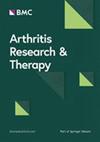在真皮纤维化模型中,BMS-470539的抗衰老活性与抗纤维化作用相关
IF 4.6
2区 医学
Q1 Medicine
引用次数: 0
摘要
像纤维化、类风湿关节炎或癌症这样的疾病,曾经被视为不同的疾病,现在被认为具有惊人的共同致病机制。这种趋同的关键在于成纤维细胞,它是疾病进展、组织损伤和慢性的关键驱动因素。尽管成纤维细胞具有核心的致病作用,并且作为治疗靶点的认识也越来越多,但针对成纤维细胞的有效治疗仍然难以捉摸,这在疾病干预方面留下了一个关键的空白。在这里,我们提出了一种新的靶向纤维化的方法,使用黑素皮质素化合物BMS-470539治疗体外培养的人皮肤成纤维细胞,这些成纤维细胞来自健康志愿者和系统性硬化症患者,并结合显微镜、DNA测序、细胞迁移、RNA测序和PCR技术测量衰老和成纤维细胞活化的各种标志物。我们还使用体内博来霉素诱导小鼠皮肤纤维化来确定BMS-470539的临床前疗效。BMS-470539诱导来自系统性硬化症患者的人真皮成纤维细胞进入“衰老样”状态,其特征是增殖停止,缺乏促炎分泌组,无法诱导继发性衰老。这种衰老样活性(伴有β-半乳糖苷酶活性、脂褐素积累等标志物)导致纤维化标志物下调,包括:平滑肌动蛋白、迁移、CCL2以及TGFβ和成纤维细胞活化相关基因。在体内,当腹腔给药时,该化合物减少了博莱霉素诱导的皮肤纤维化小鼠模型的皮肤厚度,重要的是,当皮下给药时,这种类似衰老的活性不会引起纤维化迹象。在这里,我们介绍了一种新的策略,在皮肤纤维化的背景下,使用一种治疗性的促衰老方法,使用非常规的黑素皮质素化合物BMS-470539,来重置成纤维细胞的行为并破坏疾病进展。这项工作还强调了如何理解疾病之间的共同致病机制可能带来新的治疗机会,以管理关节炎和纤维化等多种疾病的转化潜力。本文章由计算机程序翻译,如有差异,请以英文原文为准。
The senescence-like activity of BMS-470539 is associated with anti-fibrotic actions in models of dermal fibrosis
Conditions like fibrosis, rheumatoid arthritis or cancer, once seen as distinct diseases, are now recognized to share strikingly common pathogenic mechanisms. The key to this convergence lies in the fibroblast, a pivotal driver of disease progression, tissue injury and chronicity. Despite this central pathogenic role and growing recognition as a therapeutic target, effective treatments targeting fibroblasts remain elusive, leaving a critical gap in disease intervention. Here we present a novel approach to target fibrosis using the melanocortin compound BMS-470539 to treat in vitro cultured human dermal fibroblasts obtained from healthy volunteers and systemic sclerosis patients and measuring various markers of senescence and fibroblast activation combining microscopy, DNA sequencing, cell migration and RNA sequencing and PCR techniques. We also used the in vivo bleomycin induced skin fibrosis in mice to determine pre-clinical efficacy of BMS-470539. BMS-470539 induced a ‘senescence-like’ state in human dermal fibroblasts from systemic sclerosis patients, characterised by proliferation arrest, lack of pro-inflammatory secretome and inability to induce secondary senescence. This senescence-like activity (accompanied by β-galactosidase activity, lipofuscin accumulation and other markers) resulted in the downregulation of fibrosis markers including ⍺-smooth muscle actin, migration, CCL2 and genes related to TGFβ and fibroblast activation. In vivo, the compound reduced skin thickness on the bleomycin-induced skin fibrosis murine model when administered intraperitoneally, and importantly, this senescence-like activity did not cause signs of fibrosis when administered intradermally. Here, we introduce a novel strategy to disarm pathogenic fibroblasts in the context of skin fibrosis using a therapeutic pro-senescence-like approach using the unconventional melanocortin compound BMS-470539, to reset fibroblast behaviour and disrupt disease progression. This work also emphasizes the translational potential of how understanding shared pathogenic mechanisms across diseases may lead to new therapeutic opportunities to manage multiple diseases like arthritis and fibrosis.
求助全文
通过发布文献求助,成功后即可免费获取论文全文。
去求助
来源期刊

Arthritis Research & Therapy
RHEUMATOLOGY-
CiteScore
8.60
自引率
2.00%
发文量
261
审稿时长
14 weeks
期刊介绍:
Established in 1999, Arthritis Research and Therapy is an international, open access, peer-reviewed journal, publishing original articles in the area of musculoskeletal research and therapy as well as, reviews, commentaries and reports. A major focus of the journal is on the immunologic processes leading to inflammation, damage and repair as they relate to autoimmune rheumatic and musculoskeletal conditions, and which inform the translation of this knowledge into advances in clinical care. Original basic, translational and clinical research is considered for publication along with results of early and late phase therapeutic trials, especially as they pertain to the underpinning science that informs clinical observations in interventional studies.
 求助内容:
求助内容: 应助结果提醒方式:
应助结果提醒方式:


